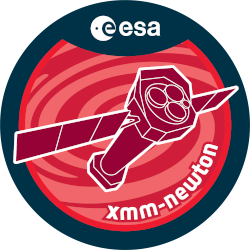

| Proposal ID | 074099 |
| Title | XMM follow-up of the massive particle accelerator HD167971: half a period after! |
| Download Data Associated to the proposal | https://nxsa.esac.esa.int/nxsa-sl/servlet/data-action-aio?obsno=0740990101 |
| DOI | https://doi.org/10.5270/esa-0y3aidp |
| Principal Investigator, PI | Dr Michael De Becker |
| Abstract | The investigation of massive colliding-wind binaries offers the opportunity toprobe stimulating physical processes, including copious X-ray emission andparticle acceleration. Among the massive systems known accelerate particles,HD167971 is of particular interest in the sense that it is a quite long periodsystem (about 21 years) whose wind-wind interaction is a powerful thermal (inX-rays) and non-thermal (in radio) emitter, despite the significant geometricaldilution of the wind outflows due to the rather large stellar separation. Thisfact makes HD167971 the longest period massive system accelerating particleswhose X-ray emission is easily accessible with present observatories. The aim isto pursue its X-ray study in light of new crucial information about its orbit. |
| Publications |
|
| Instrument | EMOS1, EMOS2, EPN, RGS1, RGS2 |
| Temporal Coverage | 2014-09-09T01:47:20Z/2014-09-09T09:14:00Z |
| Version | 17.56_20190403_1200 |
| Mission Description | The European Space Agencys (ESA) X-ray Multi-Mirror Mission (XMM-Newton) was launched by an Ariane 504 on December 10th 1999. XMM-Newton is ESAs second cornerstone of the Horizon 2000 Science Programme. It carries 3 high throughput X-ray telescopes with an unprecedented effective area, and an optical monitor, the first flown on a X-ray observatory. The large collecting area and ability to make long uninterrupted exposures provide highly sensitive observations. Since Earths atmosphere blocks out all X-rays, only a telescope in space can detect and study celestial X-ray sources. The XMM-Newton mission is helping scientists to solve a number of cosmic mysteries, ranging from the enigmatic black holes to the origins of the Universe itself. Observing time on XMM-Newton is being made available to the scientific community, applying for observational periods on a competitive basis. |
| Creator Contact | https://www.cosmos.esa.int/web/xmm-newton/xmm-newton-helpdesk |
| Date Published | 2015-09-26T22:00:00Z |
| Last Update | 2025-08-04 |
| Keywords | "XMM", "HD167971", "easily accessible", "radio emitter", "geometrical dilution", "accelerate particles", "stellar separation", "wind wind interaction", "wind outflows", "powerful thermal", "massive systems", "particle acceleration", "makes hd167971", "period system", "xray emission", "copious xray emission" |
| Publisher And Registrant | European Space Agency |
| Credit Guidelines | European Space Agency, Dr Michael De Becker, 2015, 'XMM follow-up of the massive particle accelerator HD167971: half a period after!', 17.56_20190403_1200, European Space Agency, https://doi.org/10.5270/esa-0y3aidp |